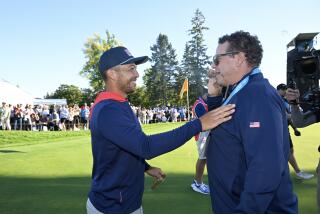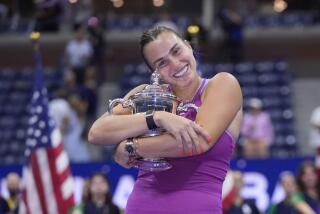U.S. Open Thunder
- Share via
NEW YORK — Staggered and sick one match, tight and worried the next, Pete Sampras put on an impeccable show of force and grace in the final Sunday night to claim his fourth U.S. Open championship.
From his first 125 mph service winner to his last at 117 mph, Sampras defended his title by blowing away Michael Chang, 6-1, 6-4, 7-6 (7-3), in two hours.
Sampras secured his No. 1 ranking and salvaged a tortured year by dominating Chang in every aspect of the match, even winning long rallies to prove he could beat Chang at his own game.
To see Sampras sprinting so lightly, moving so quickly and hammering shots so hard for his eighth Grand Slam title, no one who hadn’t heard of his problems a few days earlier would believe he could have been so close to defeat in the quarterfinals.
“I never thought I’d be here as a winner,” Sampras said. “This is the most difficult [championship] I ever won. The ranking was up for grabs, but the title is so much more important than the ranking. I wanted the title.
“This was one of the best matches I played in my career. I had to adapt and I did that today. Everything was clicking. These are the kind of days you dream about, especially in the final.”
The grit Sampras exhibited in beating Alex Corretja in the quarterfinals, even after vomiting and wobbling wearily on court in their fifth-set tiebreaker, showed up in his unflinching attack against Chang.
The slip of concentration, the bit of a choke that sent Sampras into a fourth set against Goran Ivanisevic in the semifinals, helped him in this match by steeling him against any letdown.
Sampras put together all of his skills--his awesome, accurate serves, his penetrating groundstrokes, his stinging volleys and leaping overheads--to fashion a victory as artful as it was overwhelming.
“Pete played some great tennis today,” Chang said. “It was one of those tough days.”
Sampras, who measures his year by his Grand Slam victories, would have considered 1996 a failure if he let this match get away. He fell early in the Australian Open, in the semifinals at the French Open and in the quarterfinals at Wimbledon. More significant than any of that, he had suffered emotionally the whole year as his coach and friend, Tim Gullikson, lay dying of brain cancer and passed away in May.
“Today is Tim’s birthday. He would have been 45 today,” Sampras said. “I was thinking about him all day today, all during the match. I still felt his spirit in my heart.”
Sampras played near-perfect tennis in the first set, starting with that 125 mph service winner on the first point, followed by two of his 13 aces and a 120 mph service winner to take the game.
After that welcome to his first U.S. Open final, Chang looked shaken and tight. Before he could settle into the match, he found himself broken twice, trailing 5-0 amid a flurry of his own errors and Sampras aces and winners.
Chang, still searching for his second Grand Slam title seven years after capturing the French Open at 17, didn’t begin to steady himself until he was down another break at 2-0 in the second set. Chang held twice in a row for the first time, and at 3-2 finally found the range on returns to put some pressure on Sampras, who accommodated him with a double-fault on his second break-point to make it 3-3.
The fans let loose a loud roar, hoping Chang would mount a comeback and at least make it close. They had endured the long wait during a thunderstorm and, as always, wanted to see their money and patience rewarded.
What they got was a third-set tiebreaker that Sampras dominated as much as he did the first set to take the $600,000 winner’s check.
“The first two sets, I played as well as I could,” Sampras said. “I got off to such a great start, really set the tone. I played the best of the tournament against Michael.”
Chang, who took home $300,000, lost to Sampras for the ninth time in their last 10 meetings.
This final was the last match in the 18-year-old, 20,000-seat stadium, which will be lopped off near the top and reduced to a 10,000-seat show court outside the new 23,500-seat stadium next year.
Sampras didn’t wax nostalgic about the court, though he produced some of his most memorable victories on it. It was here that he became the youngest Open champion in 1990, beating Andre Agassi in straight sets, and here that he won again in 1993 against Cedric Pioline and last year against Agassi once more.
More to Read
Go beyond the scoreboard
Get the latest on L.A.'s teams in the daily Sports Report newsletter.
You may occasionally receive promotional content from the Los Angeles Times.










